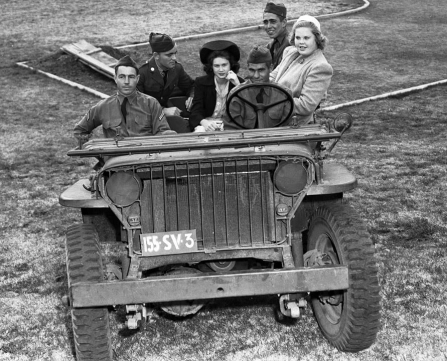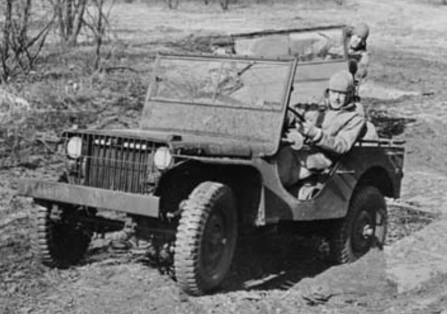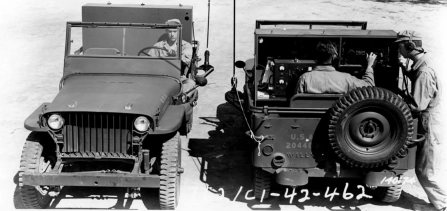Ivo Rigter Sr.
Founder & Co Owner of BAIV and Tracksandtrade
+31 6 518 22 502 ivosr.rigter@tracksandtrade.comThis Willys MB 'glove box slat', proudly residing in sunny Spain, is probably the rarest production Jeep.
Built on 14 February 1942, this Willys Script belongs to the very last series of the iconic “slat grille” models. Unlike the earlier versions, this late-production example is fitted with a glove compartment, making it part of a limited run built only between February and May 1942 with just around 5,000 units produced in this rare configuration.
Lovingly cared for by its current owner for more than 36 years and continues to be regularly driven and enjoyed, so some wear and tear is obviously visible. Although an older restoration, this Willys remains in good condition, both mechanically and structurally.
Overall, the vehicle is in good mechanical and structural condition. While it is not a “showroom” example, it is a very solid and reliable working Jeep that I still use regularly, mostly for everyday outings such as taking the dogs for a walk. Despite this, it has always been properly maintained and kept in top running order. According to the owner the body is exceptionally solid, showing no signs of rot or corrosion, apart from a few minor surface spots that are barely noticeable, including some light oxidation on the axles and springs underneath. Overall, it is remarkably sound, and no bodywork or structural repairs will be needed by the new owner.
The only major task ahead is, if desired, a complete repaint. Since the owner bought the Jeep in 1989 the Jeep has always been finished in NATO Green but over the years since the last respray it has faded in the Spanish sun. A repaint will bring its appearance fully in line with its outstanding condition.
The bodywork is almost entirely original, except for the following parts which have been replaced over time:
The front right wing, replaced due to corrosion of the inner supports (top hat members).
The floor top hat members, which were rebuilt using non-rusting reinforcements to prevent future rot.
The rear tub panel behind the rear seat, which had been poorly repaired and riveted by the Norwegian Army and has since been corrected.
Mechanically, the Jeep is in very good order. The engine was completely rebuilt in 2020, including a new block, pistons, liners, valves, camshaft, timing belt, gaskets, and seals. All parts were supplied by Jeep Sudest in France. The canvases were also fully renewed.
Originally a radio Jeep in the Norwegian Army, it still features the larger generator (dynamo) which meant that the battery had to be relocated from the engine compartment to between the two front seats in its own covered compartment. Non-original items are limited to the front indicator lights (modern replacements for the original blackout sidelights, which I have kept for the next owner). The Norwegian-installed heater has also been removed but retained.
Finally, note that the gearbox label shows it was rebuilt by the U.S. Army Ordnance Depot in occupied Japan; a rather unique historical detail.
WILLY’S REPAIRS & RENOVATIONS
1992–1999
1992: Steering, brakes, and suspension renovated
1997: New muffler
1998: Engine valves, springs, and gaskets replaced
1999: Canvas and small fittings (straps, etc.) renewed
2003–2008
2003: Starter switch replaced
2005: Transmission and steering oil seals, engine mounts replaced; new thermostat
2008: New muffler
2010–2013
2010: Starter switch replaced
2011: New water pump and steering overhaul
2012: Temperature gauge replaced with original; full body restoration (chassis separation, bare metal respray, anti-rust treatment, new top hat members, underseal throughout)
2013: Starter motor and carburettor overhauled
2014–2015
2014: Starter switch replaced
2015: New water pump
2018–2021
2018: Major engine rebuild at 23,754 miles (clutch, camshaft, crankshaft reground & balanced)
2019: New silencer and flexi pipe; front right wing replaced; new thermostat
2020: Brakes renovated; new windscreen frame installed
2021: Tires replaced; new D-Day style canvas top and cushion covers fitted
2025
2025: Cooling system renovated
2025: Vehicle exterior returned to period-correct appearance with the late model pressed grill replaced by a replica early-war slat grill. The later grill is included with the sale.
After securing the contract to manufacture the WWII quarter-ton truck, Willys produced the early Willys MA model, which evolved into the Willys MB. These initial MB jeeps, built from November 1941 to March 1942, are recognized for their unique “slat grille” made from iron bar stock. This distinctive feature, limited to the first 25,808 units, was later replaced by Ford's stamped steel grille design, which reduced production time and weight while incorporating airflow deflectors.
Differences
The slat grille MB differed significantly in both structure and functionality compared to later models. Early models lacked a glove box, meaning components like the fire extinguisher were mounted near the passenger side toe board. Early production also used a shorter windshield frame, which was later extended by two inches to accommodate taller drivers. Up to truck no. 164,554, the windshield featured push-button fasteners for the canvas top and uniquely placed hold-down catches to secure the windshield in its folded position. Other distinguishing features included the brass data plates, a solid black plastic steering wheel, and a speedometer graduated in 5 mph increments, along with a fuel gauge labeled “GAS” instead of “FUEL.”
The vehicle's body design included several unique elements, such as two separate small hinges on the toolbox lids instead of a continuous hinge, and locks keyed to match the H700 ignition key. The slat grille MBs were also distinct for their fuel tank well, which was box-shaped rather than rounded as seen in later models. The early jeeps did not include certain accessories, such as trailer light sockets or fuel can carriers, until mid-1943. Another distinctive feature of the slat grille jeeps was the use of rubber parts, including rubber shifter boots, seals around the fuel tank, and rubber hood blocks, which were later replaced with wood as wartime material rationing increased.
Mechanically, early MB models were prone to veer to the left during heavy braking due to the axle-mounted bell crank, which was later corrected with the addition of a torque reaction spring to the driver’s side front spring. The frame and suspension also included early design traits, such as solid disc wheels on pre-standardized units and early Kelsey-Hayes solid wheels used until truck no. 120,700. The AC Spark Plug Co. provided a distinctive “hat style” air filter for these early jeeps, which was later replaced by the Oakes model in subsequent versions.
The slat grille MBs came with various specialized components not found on later models. For instance, the fuel tank was equipped with a narrow neck that required a smaller cap, and the exhaust system initially used a round muffler before switching to an oval design. These jeeps also had a Holland Hitch Co. T-60-A pintle hook without trailer safety chain eye bolts, which were added in later production.
Fun Fact: Grille or Grill?
Collectors and enthusiasts seem to use the two terms interchangeably have you ever wondered which is correct?
Grammatically speaking, “grill” — both as a verb and as a noun— relates to cooking food over a metal structure placed over a fire.
“Grille,” on the other hand, refers to a metal structure of bars built around or across something to ensure its protection.
Based on that, the thing protecting the radiator on either a Willys or Ford Jeep is a "grille."
But if you really want to be correct, Ord 9 SNL G-503, List of Service Parts for Truck, 1/4-ton, 4x4, Command Reconnaissance (Ford Model GPW; Willys, Model MB), refers to that protective piece in front of the radiator as neither. Instead, it labels it as a "guard" (part number WO-A3615).













LOT NUMBER
Each lot is assigned a specific lot number. This number is allocated one day before the lots are opened for bidding.
VIEWING DAYS
Inspections during viewing days are on: Saturday December 13, 2025.
Participation in the viewing days is subject to specific conditions.
Given the fact that these are often very special items whose condition, no matter how hard we try, cannot always be described 100% completely, we really recommend that you make use of this.
IMPORTANT DATES
Auction catalogue online: October 21st, 2025, 19.00 (CET)
Bidding starts: Friday, December 12, 2025, 18.00 (CET)
Bidding ends: Saturday, December 20, 2025, 19.00 (CET)
TIMES
Amsterdam NL (CET): 07:00 PM (19:00)
London: 08:00 PM (18:00)
New York USA: 13:00 AM (13:00)
Sydney AUS: 05:00 AM (05:00), next day
BUYER’S PREMIUM
On all lots a buyer’s premium of 16,5% of the hammer price is charged. Over this buyer’s premium a 21% sales tax (VAT) will be applicable.
VEHICLES & VEHICLE RELATED EQUIPMENT
This lot is sold strictly as described in the auction listing on our website (https://tracksandtrade.com/).
Cars, motorcycles, trucks, cannons or howitzers, armored vehicles, and tanks are sold in as-is/where-is condition, with no technical guarantee and guarantee of authenticity and with or without registration.
ARMS & WEAPONS
The Auction House will not supply ANY item unless the correct paperwork and licensing – if needed – has been supplied by the Buyer in full.
If required and applicable (fire)arms can be made inoperable or permanently disabled by BAIV in The Netherlands as being a licensed Arms & Weapons Dealer Registration Nr. NL20191618779. In this case all relevant cost will be charged to the Buyer in addition and have to be paid in advance in full. Collection by appointment only.
Deactivated weapons (EU regulation)
A deactivated weapon is a genuine firearm that has been modified so it can no longer discharge any bullet, missile, or other projectile.
Legal basis
All deactivated weapons offered in this auction are deactivated/neutralized in accordance with EU Regulation 2015/2403, as incorporated into Dutch law on 13 May 2016.
Delivery within the EU (European buyers)
To ship a deactivated firearm we must verify that you are at least 18 years old.
Please provide a copy of a valid identity document (ID card, passport or driver’s license).
Once we have received and checked this document, we can send the deactivated weapon and its certificate at the buyer’s expense.
Important note
No lot will be delivered or shipped without the presentation of the documents mentioned above.
The buyer is responsible for their purchase once the lot is awarded and will pay at least the related costs.
Delivery outside the EU (non‑European buyers)
If you are a non‑EU resident intending to purchase an EU deactivated weapon, it is your responsibility to confirm whether ownership is permitted under the laws of your country.
You may need to provide a valid firearm license before we can ship your purchased deactivated weapon, as we comply with Dutch export regulations for (deactivated) weapons.
Any additional actions required and associated costs in such a transaction will be charged to the buyer.
MARGIN/ VAT
However, for most of the lots 21% sales tax (VAT) over the hammer price will be not applicable, it might be that in some specific cases sales tax (VAT) over the hammer price will be charged. In such a case this will be specifically specified in the lot description. For all other lots the margin scheme will be applicable. For more info see our General Conditions of Sale Article 9 on our website; www.tracksandtrade.com
IMPORT & EXPORT
Depending on the destination and content of the Lot the Buyer shall obtain an International Import Certificate / End User Certificate. Some of the items listed in the auction may require special licenses or permits or existing documents must be prepared for export. If this is relevant, Tracks & Trade will take care of this. The applicable costs will be charged to the successful bidder. Please email accounting@tracksandtrade.com if you have any questions or concerns. No item will be allowed to be collected without 100% of all legal requirements being fulfilled.
COLLECTION
Specific address details will be provided upon request and to the successful bidder/ Buyer.
Delivery: Ex Works.
LOT REMOVAL DEADLINE
All lots must be collected no later than Friday, February 7, 2025, and only after full payment has been received and all legal requirements have been met.
No storage fees will be charged prior to this date. After this period, storage fees will apply.
For buyers from the United States or other distant destinations, tailored arrangements can be made upon request.
SHIPPING & HANDLINGS COSTS
All shipping, packaging, and any special handling expenses (e.g., crane hire or specialized equipment) are the sole responsibility of the Buyer and will be invoiced at actual cost plus a 10% handling fee.
LATE PICK-UP & STORAGE FEES
Any lot not collected by Saturday, February 7, 2025, will be placed in secure storage at the Buyer’s expense, with the following weekly storage rates applied (excluding 21% VAT):
Parts & accessories: €25 per lot per week
Cars and motorcycles: €50 per lot per week
Armored vehicles, tanks, cannons, etc.: €75 per lot per week
Need Assistance?
Please feel free to contact us for support or questions:
Phone: +31 6 518 22 502
Email: info@tracksandtrade.com
We are here to guide you through every step of the process and will do our utmost to assist you.
DELIVERY
The buyer is responsible for the transportation of the purchased goods, unless otherwise agreed. Tracks & Trade can assist with or arrange transportation at additional cost. Please contact us for more information.
Shipping, and packing costs and special costs that arise for loading special items, such as crane costs or costs for hiring special equipment etc., will be charged to the Buyer on the basis of actual costs + a surcharge of 10%. Naturally, you can count on us when it comes to the shipment of your purchases. We are happy to take care of that.
GENERAL CONDITIONS
All information and transactions are subject to the general terms and conditions (Version 2.0 dated 29-04-2022). For more detailed information visit our website.
NOTE
By placing a bid, whether successful or not, the bidder agrees to be bound by the terms and conditions as set forth on this website (www.tracksandtrade.com) and in the applicable general terms and conditions. It is the bidder’s responsibility to review and familiarize themselves with all such terms prior to placing a bid.
After buying a classic military vehicle or other items such as cannons, planes, howitzers and tanks, there are several steps you would typically need to take:
Legalities
In principle, no special permit is required for unarmored wheeled and tracked vehicles. In many cases, an export procedure that is comparable to that for exporting classic cars and motorcycles is sufficient. Military collectables older than 75 years and with a value over Euro 50k are considered as National Heritage. In such cases an export permit must be requested from the National Ministry of Culture of the exporting country. Tanks, howitzers and self-propelled or towed cannons often require specific permits that are highly dependent on the country of shipment and the country of destination. This may involve registering the item with the appropriate authorities and complying with any regulations regarding its ownership and use. In such a case it is advisable to contact us in advance because we have many decades of experience in the import and export of Classic Military Heritage. Based on this experience, we can generally quickly provide feedback on what applies to you. This is especially relevant because regulations in this regard change every now and then and sometimes, we also have to deal with export-restrictions. In short: if you want to be sure, contact us in time to avoid difficulties at a later stage.
Storage
Find a suitable storage location for your collectable, preferably a secure and legal place where you can keep it when not in use. This could be a garage, warehouse, or even a specially designed storage facility or museum.
Transportation
After you have all the paperwork in place the next step will be the (oversees) transport to your desired location. This may involve hiring specialized transport and broker services due to permits, size and weight. In this case we can also support you with organizing the transport or make sure you get in contact with dedicated brokers and import agents.
Maintenance and Restoration
Depending on the condition of your military collectable, our partner BAIV can help you with maintenance and restoration work to ensure that it is safe and operational. This could involve relatively easy maintenance and repair or service till a Class-A restoration. In such a case please contact BAIV (info@baiv.nl).
Training
If you intend to operate a vehicle then make sure you have manuals that describe how to operate the vehicle. Nowadays there are numerous reprints available on the Internet that explain to you in a playful way how to drive and operate your vehicle. This is often a team effort, which makes owning such a vehicle extra attractive. If required, you can also involve/hiring a professional instructor or attend specialized training courses to learn how to drive and maintain it safely. In such a case, our partner BAIV (www.baiv.nl) can also support you
Insurance
Consider obtaining insurance coverage for your vehicle to protect yourself against any potential accidents or liabilities that may arise from owning and operating it. Often there are specialized insurance companies offering these kinds of services. Local military vehicle clubs often also know their way around the specific options offered by insurance companies.
Enjoyment
Finally, once everything is in place, you can enjoy owning and, if permitted, operating your classic military vehicle, cannon or howitzer. Whether it's for display purposes or for participating in historical reenactments, owning such a great unit can be a unique and rewarding experience.
Ivo Rigter Sr.
Founder & Co Owner of BAIV and Tracksandtrade
+31 6 518 22 502 ivosr.rigter@tracksandtrade.com